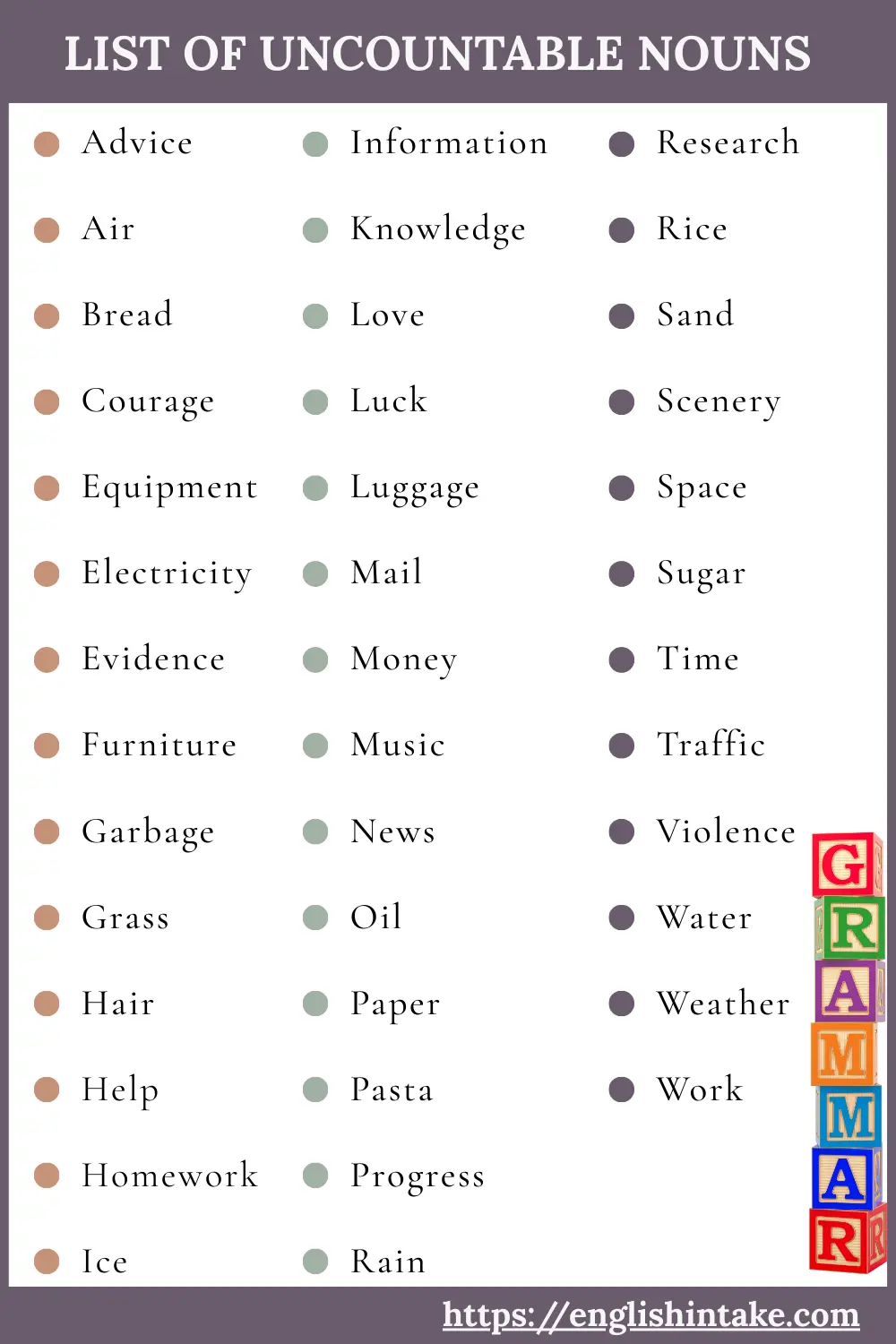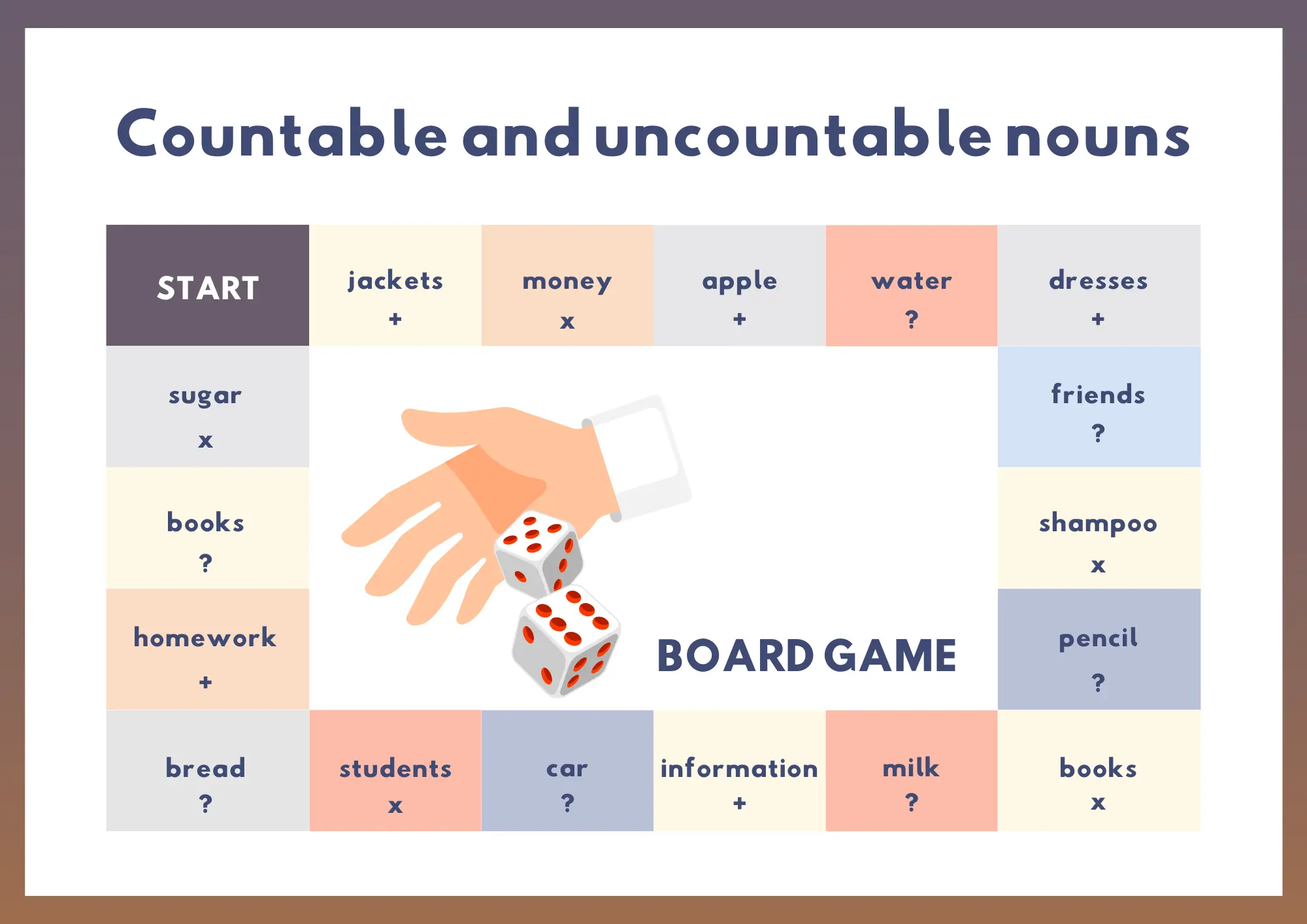1. What are uncountable nouns?
Uncountable nouns are things we cannot count one by one. We do not use the articles a or an before them. In addition, they do not have plural forms. We use quantifiers like some, much, a little, or a lot of before uncountable nouns.
It is incorrect to say say a water, three rices, or two advices because we cannot count them with numbers like one, two, or three.
Uncountable nouns are seen as a whole or a mass, not as individual items. So instead of using numbers, we use quantifiers to quantify them. For example, we say some water, a little rice, or a piece of advice.

Examples:
1. I need some water.
2. She put a little sugar in her coffee.
3. We listened to a lot of music at the concert.
4. He has a lot of information about the project.
5. We don’t have much information on that.
6. They bought new furniture for their house.
7. There is a lot of traffic during rush hour.
8. We don’t have much time to finish the homework.
9. I don’t have much patience for long meetings.
10. Is there much interest in the event?
11. She hasn’t made much progress on her work.
Below is a non-exhaustive list of uncountable nouns.
1. advice
2. air
3. bread
4. courage
5. equipment
6. electricity
7. evidence
8. furniture
9. garbage
10. grass
11. hair
12. help
13. homework
14. ice
15. information
16. knowledge
17. love
18. luck
19. luggage
20. mail
21. money
22. music
23. news
24. oil
25. paper
26. pasta
27. progress
28. rain
29. research
30. rice
31. sand
32. scenery
33. space
34. sugar
35. time
36. traffic
37. violence
38. water
39. weather
40. work
2. What are countable nouns?
Countable nouns can be counted as individual items. They have singular and plural forms. For example, we can say one apple, two apples, three chairs, or five books. We can also use words like many, a few, several, or a lot of with countable nouns. For example, we can say a few bananas, many students, or several emails.
Below is a non-exhaustive list of countable nouns.
1. apple
2. bag
3. car
4. desk
5. egg
6. fork
7. glass
8. house
9. jacket
10. key
11. lamp
12. mirror
13. notebook
14. orange
15. pen
16. quilt
17. ring
18. spoon
19. table
20. umbrella
21. vase
22. watch
23. chair
24. yoghurt
25. zipper
26. box
27. cup
28. door
29. envelope
30. fridge
31. glove
32. hat
33. iron
34. window
35. kettle
36. shoe
37. mug
38. napkin
39. pencil
40. plate
3. Quantifiers
In English, we use quantifiers to talk about the amount or number of something. Some quantifiers are used only with countable nouns, while others are used only with uncountable nouns. Below are tables summarising the use of quantifiers for each type of noun, along with examples to help you understand how they work.
3.1 Quantifiers used with countable nouns only
a/anUse a or an for singular countable nouns.
1. a book
2. an apple
manyUse many for plural countable nouns to indicate a large quantity.
1. many books
2. many apples
few / a fewUse few for a small quantity, or a few for a slightly larger (but still small) quantity.
1. few friends
2. a few ideas
severalUse several to indicate an unspecified but moderate quantity.
1. several books
2. several apples
a number ofUse a number of to indicate an unspecified quantity.
1. a number of books
2. a number of apples
3.2 Quantifiers used with ucountable nouns only
| Quantifier | Example |
|---|---|
| a little | We need a little sugar. |
| much | There isn’t much water in the bottle. |
| a bit of | Can I have a bit of advice? |
| a great deal of | She has a great deal of experience. |
| less | You should eat less salt. |
3.3 Quantifiers used with both countable and uncountable nouns
someI saw some birds.
I need some milk.
anyDo you have any pens?
Is there any butter left?
noThere were no emails today.
There is no time to waste.
a lot ofWe saw a lot of tourists.
I drank a lot of water.
lots ofShe has lots of books.
He has lots of energy.
plenty ofThere are plenty of chairs.
We have plenty of juice.
enoughWe have enough pencils.
Do you have enough sugar?
4. Board game

Follow the instructions below to play the board game.
1. Form groups of four or five players.
2. Each player takes turns rolling the dice and moving their token accordingly.
3. When you land on a square, create a positive sentence (+), a negative sentence (–), or a question (?) using the words provided.
4. Be sure to include the quantifiers we've studied: a/an, some, any, a lot of, much, and many.
5. The group that first reaches the last square wins the game.
